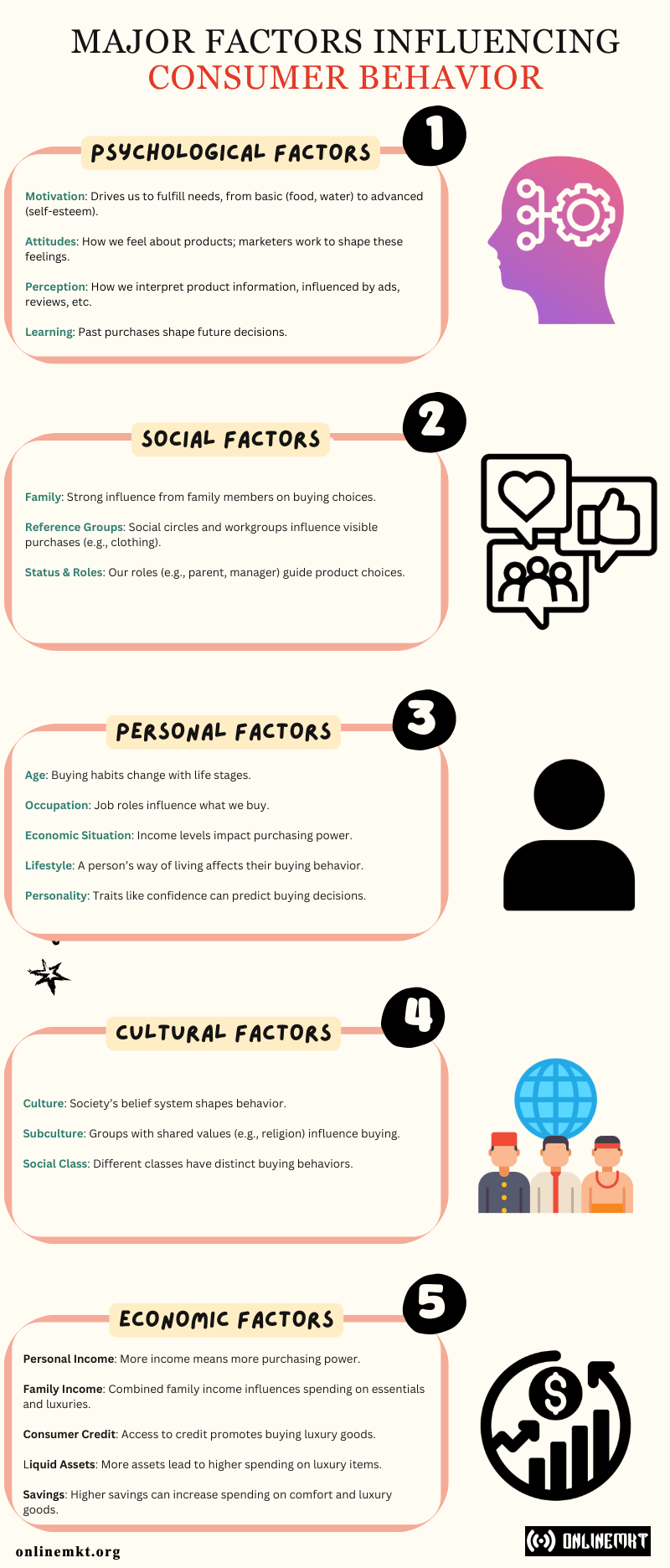What Influences Consumer Behaviour?

From celebrity endorsements to the music playing in a store, countless factors subconsciously nudge our buying decisions.
Consumer behavior is a fascinating blend of psychological, social, and cultural factors. Emotions play a crucial role; when people feel excited or connected to a brand, they’re more likely to make a purchase. For example, nostalgia can drive sales – a simple ad evoking happy childhood memories can create a powerful urge to buy. Social influences, like friends’ recommendations or trending products on social media, can also sway decisions, making consumers feel part of a community.
Major Factors Influencing Consumer Behavior
Five major factors influence whether a target customer buys a product: psychological, cultural, economic, social, and personal factors.
Psychological Factors
- Motivation: This inner drive propels us to fulfill our needs, ranging from basic physiological needs like food and water to higher-level needs like self-actualization and esteem.
- Attitudes: How we feel about products, services, or companies. Marketers aim to change attitudes and beliefs to improve brand image and consumer buying behavior.
- Perception: The way consumers interpret information about a product significantly influences their buying decisions. This includes advertisements, reviews, and social media feedback.
- Learning: Purchasing a product provides knowledge and experience, which influences future buying decisions.
Social Factors
- Family: Family members greatly influence buying behavior. Preferences often develop in childhood and continue throughout life.
- Reference Groups: Social groups, workgroups, or close friends that consumers identify with can affect their buying choices, especially for visible products like clothing or cars.
- Status and Roles: Our roles and statuses in society, such as a mother or a finance manager, influence the products we choose to reflect these roles.
Personal Factors
- Age: Buying habits change with age and life stages. Marketers develop products for different stages, such as singles, young couples, or families.
- Occupation: A person’s job affects their purchasing decisions. For instance, a marketing manager might buy business attire, while a construction worker would choose rugged work clothes.
- Economic Situation: Income levels impact buying decisions. Higher-income consumers tend to purchase more expensive products.
- Lifestyle: A person’s way of living, including opinions and activities, shapes their buying behavior.
- Personality: Characteristics like self-confidence and aggression influence buying decisions and can help predict consumer behavior.
Cultural Factors
- Culture: A complex belief system about human behavior that includes societal roles and norms, significantly influences consumer behavior.
- Subculture: Groups with shared values and traditions, such as those defined by nationality, religion, or geography. Marketers target these groups with specific strategies.
- Social Class: Different social classes exhibit distinct buying behaviors, and marketers identify these classes to tailor their strategies.
Economic Factors
- Personal Income: Higher disposable income increases purchasing power.
- Family Income: The combined income of a family influences spending on essentials and luxuries.
- Consumer Credit: Access to credit, like credit cards or loans, encourages purchases of luxury and comfort goods.
- Liquid Assets: Consumers with more easily convertible assets tend to spend more on luxury items.
- Savings: Higher savings can lead to more spending on comfort and luxury goods.
Conclusion
Understanding consumer behavior, shaped by a complex interplay of personal, psychological, and social factors, is essential for businesses to connect deeply with their customers. By grasping these influences, brands can ensure their products and messages resonate, leading to success in today’s dynamic market.